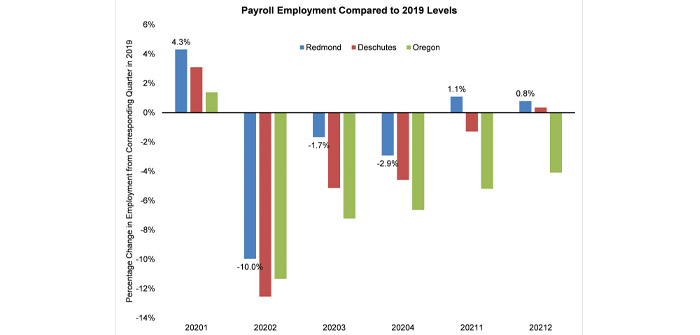(Graph | Courtesy of Bruce Barrett)
At the turn of the 20th Century, pioneer farmers, irrigation companies, railroads and entrepreneurs carved Redmond from the rocks, sagebrush and juniper trees of Central Oregon’s High Desert. It took a few years for the hardy residents to realize that the short growing season, shallow soil and open, flat topography, were better suited to industry than agriculture and recreation. Industrial and commercial activities have been the backbone of Redmond’s growth since those early days.
Redmond Grows to an Industrial Hub
Redmond’s growth as Central Oregon’s industrial hub was detailed in a June, 2021 progress report, given by Jon Stark of Redmond Economic Development, when he noted, “Industrial development square footage in Redmond grew by 700,000 in just three years. We built 1.5 million square feet over the last 100 years of being a city, yet we’ve added nearly 50 percent in just three years.” According to Stark, 2020 was the strongest year in REDI’s 34-year history in terms of number of projects and tied for the best year ever in capital investment. The existing projects planned or permitted indicates even stronger years ahead with a planned 546 jobs and capital investment of $133.5 million.
REDI provided the following chart showing the total square feet of industrial space delivered to the market from 2018 to present and documented the space development planned in the near future:
Growth is a Result of Planning
The growth of Redmond’s industrial sector would not have happened without the foresight of its citizens, economic development effort, city and regional government. For decades, Redmond has been praised by business owners and developers for its business friendly environment. A strong economic development organization, permitting process, infrastructure development and core business area planning have been designed to be business and growth friendly. An indicator of this strategy’s success was reported by John Roberts, Deputy City Administrator who provided details showing consistent growth of commercial buildings added to Redmond over the last six years with more than one billion dollars in total valuation.
Redmond is a Resilient Community for Jobs
One way to evaluate a City’s economic stability is through employment resilience during an economic downturn. During the recent pandemic, Redmond had only two manufacturing companies that reported layoffs. For business as a whole, Damon Runberg, regional economist, Oregon Department of Employment recently commented that, “The recovery has been relatively brisk in Redmond with payroll employment in the city exceeding pre-pandemic levels of 2019 by winter 2021. The most recent city data is through June 2021 where employment in the city was roughly one percent above those 2019 levels (See graph). Statewide, June employment levels still remained down by over four percent compared to those 2019 levels.”
Redmond has a Growing Commercial Support sector
It makes sense that all sectors of the community must grow to create livability. One of the five key factors in urban planning is that areas in need of renewal need special consideration. Chuck Arnold, Redmond’s Economic Development / Urban Renewal Project program coordinator, is one of the community leaders tasked with helping make this a reality. For Redmond’s Urban Renewal District, he reports that, “In the last year we are seeing more buildings sell, receive new investment and get occupied with new businesses than we’ve seen in any of the last five years. The Downtown Redmond Urban Renewal District is likely to continue to see more building improvements and a variety of new businesses as our City continues to grow.”
Rapid Growth Requires Leadership with Clear Priorities
Rapid growth can be uncomfortable and requires steady leadership with clear priorities. Redmond has detailed those priorities in its various comprehensive plans. Mayor George Endicott, in a statement on the city website, summed up those priorities for a growing city by saying, “Specifically, we must attract living wage jobs, both commercial and industrial; build an adequate transportation, water and wastewater infrastructure; ensure we build family friendly neighborhoods and parks; make sure we do everything we can to ensure schools are built as we need them; properly manage our funds and resources; and make certain our land use policies and supporting documents are kept current with and support our goals.”
Economic development and commercial activity in general has a bright future in Redmond. Challenges ahead include the need for more commercial and industrial buildings. Most commercial real estate brokers have a list of business clients of all types waiting for the next available space. A building materials price drop might be the signal for developers to start a new era of growth in Redmond.
Bruce Barrett is a Commercial Broker with Windermere Commercial Real Estate and can be reached at barrett@windermere.com.





